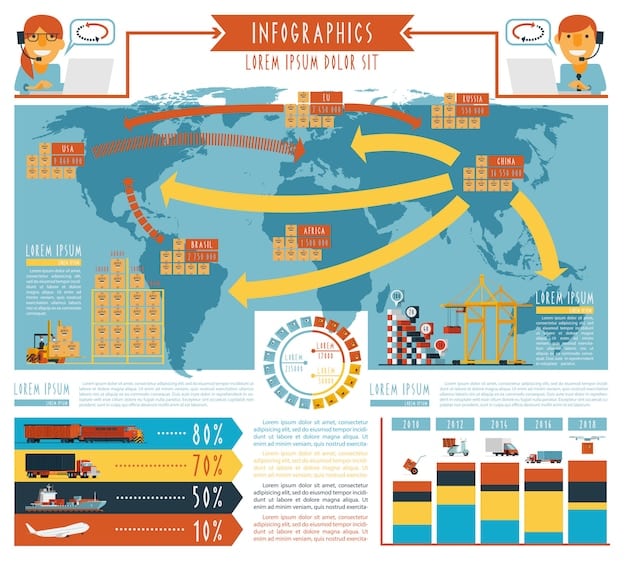Inflation’s Impact: Business Cost Strategies for Profit Margins

Inflation significantly impacts business costs, necessitating strategic approaches to maintain profit margins through optimized pricing, efficient operations, and effective financial management.
Navigating the complexities of inflation is crucial for businesses striving to maintain profitability. Understanding the impact of inflation on business costs: strategies for maintaining profit margins is essential for making informed decisions and implementing effective measures to mitigate financial challenges.
Understanding Inflation’s Impact on Business Costs
Inflation erodes the purchasing power of money, directly affecting various business costs. Recognizing the specific areas where inflation exerts the most pressure is the first step toward developing effective strategies.
Businesses face increased expenses in several key areas. Some of the areas include procurement, labor, and operational overhead, squeezing profit margins if not managed effectively.
Rising Input Costs
Inflation often leads to higher prices for raw materials, components, and other essential inputs. Businesses need to assess their supply chains and identify opportunities for cost reduction.
Labor Cost Pressures
Employees may demand higher wages to cope with the rising cost of living, placing upward pressure on labor costs. Companies must develop strategies to balance employee needs with financial realities.
- Renegotiate contracts with suppliers to secure better pricing.
- Explore alternative sourcing options, including domestic suppliers.
- Invest in technology to automate processes and reduce labor needs.
Businesses must adapt to these inflationary pressures to stay competitive. The companies that proactively address these areas will position themselves for long-term success.

Pricing Strategies to Counter Inflation
Adjusting pricing strategies is a fundamental response to inflation. Businesses must carefully evaluate their pricing models to ensure they reflect increased costs while remaining competitive in the market.
Pass-through pricing, value-based pricing, and dynamic pricing can help accommodate increased costs. Finding the optimal balance between profitability and customer value is key.
Cost-Plus Pricing Adjustments
This involves adding a markup percentage to the total cost of a product or service. Businesses may need to adjust markup to reflect increased expenses.
Value-Based Pricing
Focus on the perceived value of the product or service to the customer. Justify higher prices by highlighting unique benefits and quality.
- Conduct market research to understand customer price sensitivity.
- Communicate the value of your products or services effectively.
- Offer discounts or promotions strategically to maintain sales volume.
Implementing the right pricing strategy helps to ensure continued profitability amidst rising costs. The strategy should be flexible and responsive to market conditions.
Operational Efficiency and Cost Reduction
Enhancing operational efficiency can significantly offset the impact of inflation. Businesses should identify areas where they can streamline processes, reduce waste, and optimize resource utilization.
Lean manufacturing principles, technology adoption, and waste reduction programs can yield substantial savings. Efficiency improvements not only lower costs but also enhance overall competitiveness.

Supply Chain Optimization
Reviewing and optimizing the supply chain can lead to lower procurement costs and improved delivery times. Diversifying suppliers and negotiating better terms are essential steps.
Technology Adoption
Investing in automation, data analytics, and other technologies can enhance productivity and reduce labor costs. Digital transformation is a key enabler of efficiency gains.
- Implement lean manufacturing principles to reduce waste.
- Invest in employee training to improve productivity.
- Utilize energy-efficient equipment to lower utility costs.
Streamlining operations contributes to better cost control and increased profitability. Embracing efficiency-enhancing measures provides a competitive advantage.
Financial Management Strategies for Inflation
Effective financial management is crucial for navigating inflationary periods. Businesses should focus on managing cash flow, controlling debt levels, and making strategic investments.
Cash flow forecasting, debt restructuring, and prudent capital allocation can help mitigate financial risks. Strong financial management practices provide resilience during economic uncertainty.
Cash Flow Management
Maintaining healthy cash flow is essential to meeting short-term obligations and investing in growth opportunities. Accurate forecasting and proactive management are key.
Debt Management
Reducing debt levels and securing favorable interest rates can lower borrowing costs. Restructuring debt can also improve financial flexibility.
- Monitor key financial ratios to assess performance and identify potential issues.
- Develop contingency plans to address unexpected financial challenges.
- Seek professional financial advice to optimize investment decisions.
Sound financial strategies ensure the company’s ability to weather inflationary storms. These strategies help the business to emerge stronger and more resilient.
Negotiating with Suppliers and Customers
Negotiation plays a critical role in managing inflationary pressures. Businesses should engage in constructive dialogues with both suppliers and customers to find mutually acceptable solutions.
Long-term partnerships, transparent communication, and win-win negotiations foster collaboration and mitigate conflict. Fair negotiations contribute to sustainable business relationships.
Supplier Negotiations
Building strong relationships with suppliers can lead to better pricing and more flexible terms. Transparency and mutual understanding are essential for successful negotiations.
Customer Negotiations
Communicating the value of products or services and justifying price increases can help maintain customer loyalty. Offering flexible payment options can also ease the burden for customers.
- Be prepared to walk away from unfavorable deals.
- Focus on building long-term relationships based on trust.
- Explore alternative solutions that benefit both parties.
Through effective negotiations, businesses can navigate inflationary challenges. Successful negotiations reinforce trust and commitment.
Long-Term Planning and Investment Strategies
Adopting a long-term perspective is crucial for sustainable success during inflationary periods. Businesses should focus on strategic investments that enhance productivity, innovation, and market position.
Investing in research and development, employee training, and infrastructure improvements can generate long-term value. Proactive investments position the company for future growth and competitiveness.
Research and Development
Investing in innovation can lead to new products, services, and processes that differentiate the company from its competitors. Innovation provides a competitive edge in the market.
Employee Training
Developing the skills of employees boosts productivity, morale, and overall performance. Skilled workers are more adaptable and contribute to operational efficiency.
- Establish clear goals and objectives for long-term planning.
- Monitor key performance indicators to track progress and identify areas for improvement.
- Be adaptable and willing to adjust strategies as market conditions change.
Long-term planning and strategic investments pave the way for sustained success. These measures help businesses to navigate challenges.
| Key Point | Brief Description |
|---|---|
| ⬆️ Rising Input Costs | Inflation increases the cost of raw materials and components. |
| 💰 Pricing Strategies | Adjust pricing to reflect increased costs while staying competitive. |
| ⚙️ Operational Efficiency | Streamline processes and reduce waste to offset inflation’s impact. |
| 🏦 Financial Management | Manage cash flow and control debt for financial stability. |
Frequently Asked Questions (FAQs)
Inflation increases the cost of goods and services, reducing the purchasing power of consumers. This can lead to reduced demand and lower profit margins for small businesses.
Implementing lean manufacturing principles, adopting technology for automation, and reducing waste and energy consumption are effective ways to cut operational costs.
Building strong relationships, seeking multiple bids, and consolidating purchases can lead to better terms with suppliers. Transparency helps maintain healthy relations.
Effective cash flow management ensures a business can meet its short-term obligations and invest in growth opportunities, providing stability during economic uncertainty.
Technology enhances productivity, reduces labor costs, and improves operational efficiency, helping businesses to mitigate the financial impact of rising costs because of inflation.
Conclusion
Successfully managing the impact of inflation on business costs requires a multifaceted approach that combines strategic pricing, operational efficiency, astute financial management, and proactive negotiation. By implementing these strategies, businesses can maintain profit margins and thrive in challenging economic climates.





